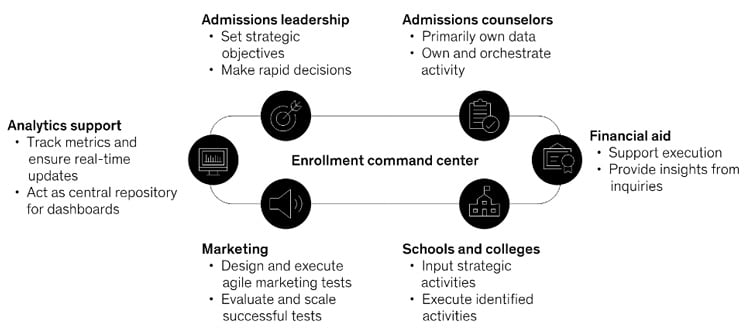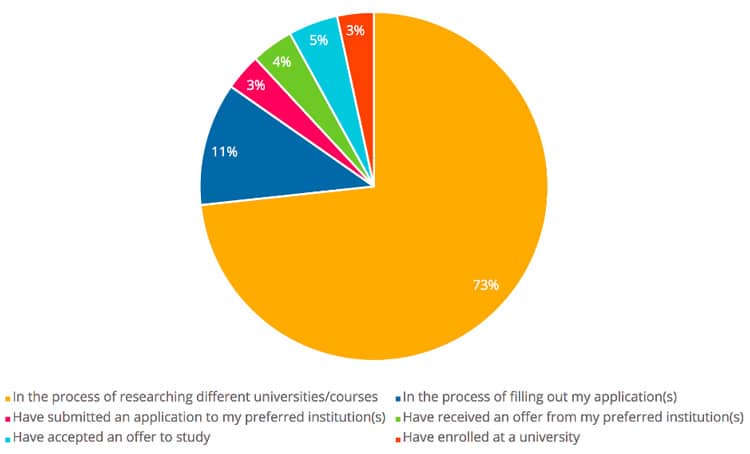International enrolment management for 2021: Virtual events and 24-hour recruiting
- The good news recently about vaccines being ready for use in 2021 may well prompt many prospective international students to double down on decision-making regarding study abroad next year
- Research has shown that high proportions of students are willing to consider alternative study destinations
- There is a corresponding opportunity to compete for students who might not have been interested in a particular country or institution before the pandemic but who are in the midst of revising study plans
- Virtual fairs are a great option, and some colleges are banding together with others in the same region to increase their visibility and attract more students than they otherwise could
- There’s also never been a better time to invest in data and systems management
It goes without saying that few educators have found 2020 to be a banner year for their international programmes. But if there’s any silver lining, many have been encouraged to innovate to such a degree that their new recruiting practices will serve them well after the pandemic is over.
A new competitive landscape
With vaccine distribution now imminent in some countries, a global economic recovery may not be so far off. Sharpened forecasts for next year anticipate a recovery in international travel and student mobility. But there are indications that students may not be travelling to the same destinations as they thought they would before the pandemic.
Thousands of surveyed students have indicated their willingness to switch destinations to receive in-person, rather than online education. Safety, already on the rise for several years as a concern for international students and parents, has only become more of a worry. Families have spent the year judging which destinations have been the most supportive of international students and which have managed their pandemic response the best. Students have had time to review alternative destinations and institutions and to even consider switching degrees or types of credential. Their financial situation may have changed in the pandemic, and the factors that were once most influential on their decisions may not be anymore. Being close to home, for example, might have become more important.
All this is not lost on the marketing and admissions staff of top institutions. As David Di Maria, associate vice provost for international education at the University of Maryland-Baltimore County, told the Chronicle of Higher Education: “What’s worked for us in the past is not what’s going to get it done for us tomorrow.” Indeed, an IIE Snapshot survey in the summer found that 84% of American colleges had adopted new international recruitment strategies as a result of the COVID crisis.
Virtual events
Virtual recruitment fairs have become a lifeline for many institutions this year. These fairs may lack the up-close-and-personal element of a fair held in a local market with prospective students, but they offer the virtue of being more affordable and able to accommodate an unlimited number of students. This is a key advantage for schools that don’t have the massive marketing budgets and staff that larger colleges have; it allows them to compete on a more level playing field.
In addition, students from numerous countries can attend, stretching the ability of a college to recruit in a wider range of markets. This is a fantastic opportunity, as this year made it crystal clear that diversifying markets has never been more important, given that the Chinese market in particular has become less dependable as a growing source of students. US and Australian universities were all too aware of this in 2020 given rising China–US and China–Australia tensions.
Still, before a virtual recruitment fair can host unlimited numbers of attendees, it must first be able to attract a critical mass of students. This can be more challenging for schools and colleges that may not have an established presence in target markets. To increase their draw, some schools are banding together. For example, the University of Texas at San Antonio and dozens of other colleges in the Study Texas consortium hosted a state-focused virtual fair in October that drew students from multiple countries. Similarly, EduCanada’s October fair for students in Anglophone Africa introduced students to marketing and admissions staff from dozens of Canadian institutions. Participation in such events is also increasingly being linked to virtual campus visits or tours.
Round the clock recruiting
Like so many other businesses, international educators know that a big part of any pandemic survival strategy is simply to hustle harder than ever before. This can mean staying up late to match time zones in target countries, introducing a live chat feature on websites, offering free goodies to prospects (e.g., a free online class or even introductory programme), and generally being agile enough to quickly jump on any opportunity.
But on a deeper level – and one that will pay off post-COVID – a key strategy is to invest in data and systems management. Reviewing website analytics daily to see where demand is coming from and for which programmes is now a must. There is so much value in this exercise; for example, Evelyn Levinson, director of international admissions at Washington-based American University, told the Chronicle that if she sees that students from a certain region are visiting the university’s site, she sends them an email invite to to a one-on-one Zoom session.
In terms of systems management, there’s never been a better time to get everyone in your school working together to influence student decision-making – from current students to alumni to faculty to admissions staff. The following diagram from McKinsey & Company provides a useful visual sketch of what this could look like across departments and staff in a university setting, but of course the same idea could be applied to institutions or schools of any size.

McKinsey suggests several ideas for how students and staff can get involved in the marketing effort, including:
- Faculty writing notes to prospective students and their parents, or inviting them to a personalised Zoom meeting;
- Students and alumni spearheading texting campaigns and buddy programmes;
- Board members and alumni joining virtual events to demonstrate their passion for their institution.
The time is now
If there’s anything that makes the case for schools and universities to fine-tune their recruiting practices as 2020 draws to a close, it’s this pie chart from QS’s October 2020 study, COVID-19 in Higher Education: How Current and Prospective Students Are Adapting. The chart shows the massive proportion of international students who are still researching where they will study abroad.

The chart takes on still more urgency when paired with a finding from another QS survey conducted in September among nearly 3,000 prospective international students: nearly nine in ten (85%) said they hoped to begin their studies in 2021.
For additional background, please see:
Most Recent
-
Canada announces international student cap numbers for 2026 and updated programme guidance Read More
-
Building the bridge to campus: The first stage of student satisfaction begins long before admission Read More
-
The power of data and narrative in building public support for international students Read More
















